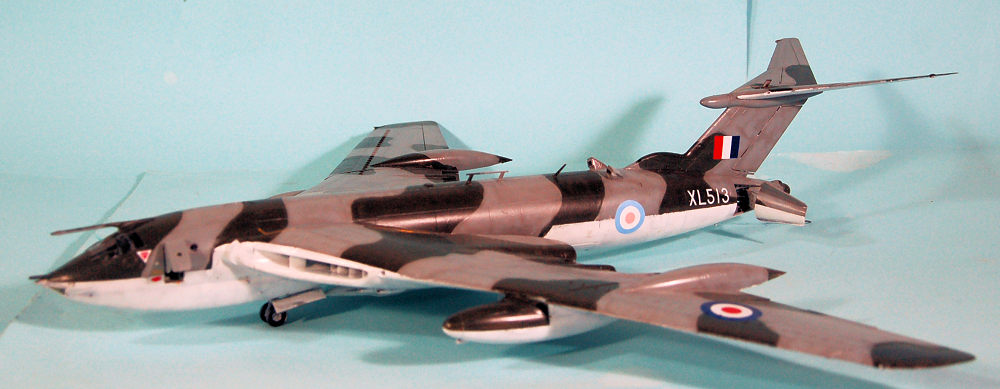
Airfix 1/72 Victor B.2
| KIT #: | A12008 |
| PRICE: | @$85.00 |
| DECALS: | Two options |
| REVIEWER: | Tom Cleaver |
| NOTES: | Xtradecals 72265 “Handley Page Victor Collection” |

| HISTORY |
Following the success of the wartime Halifax, Handley Page began looking at jet power for bombers; a tail-less swept wing design became their pet projects, which got the interest of the Air Ministry and in early 1947 an official specification. B.35/46, was issued to cover development of what Handley Page designated the HP.80. It would be one of the three “V-bombers” and an initial service date of 1951 was called for.
Handley Page tested their crescent wing and tail design, using a Supermarine type 510 fuselage designated type 521 by Supermarine. The fuselage was married to crescent-shaped wings and a T-tail, and was known as the HP.88. Coded VX330, it flew too late to be of use in the Victor program and was lost in an accident on August 26th, 1951, killing pilot Duggie Broomfield.
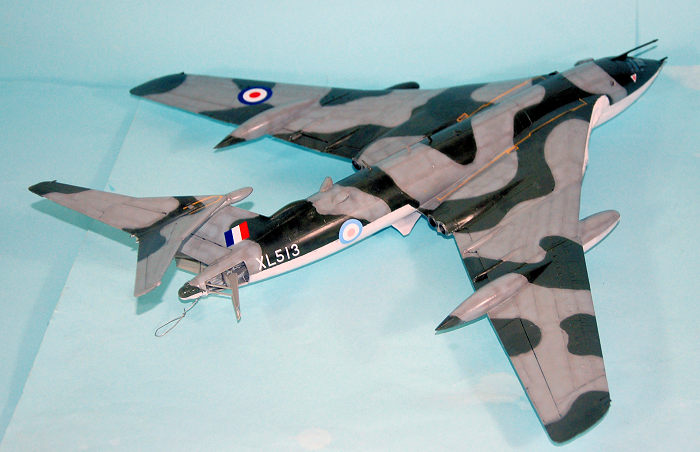 The
first HP.80, WB771, flew for the first time on December 24, 1952. In comparison
to the Vulcan and Valiant, it had a larger bomb bay and a very different crew
compartment, with the pressurized crew compartment extended to the tip of the
nose. In common with the Valiant and Vulcan, only the pilots had ejector seats.
Thus, in an emergency, the pilots could get out while the rear crew died, given
there was really no way to bale out of the side hatch right in front of the
engine intakes (there were some successful escapes however).
The
first HP.80, WB771, flew for the first time on December 24, 1952. In comparison
to the Vulcan and Valiant, it had a larger bomb bay and a very different crew
compartment, with the pressurized crew compartment extended to the tip of the
nose. In common with the Valiant and Vulcan, only the pilots had ejector seats.
Thus, in an emergency, the pilots could get out while the rear crew died, given
there was really no way to bale out of the side hatch right in front of the
engine intakes (there were some successful escapes however).
During tests of the prototypes, Handley Page's test pilots returning from flights over the North Sea would often “forget” to notify Air Traffic control that they were returning a at maximum speed and altitude in a straight line for the UK. The only fighters that could intercept them - and did - were the F-101 Voodoos of the 81st TFW, which showed how impressive the Victor was.
The first Victor B.1 flew on February 1, 1956. Fitted with more powerful Sapphire engines than used in the prototypes, the cleared maximum speed of Mach 0.95 proved pessimistic when test pilot Johnny Allam inadvertently achieved Mach 1.1 in a very shallow dive! Bomber Command became operational with the Victor in April 1958.
In late 1955, Handley Page proposed an improved Mk.2 variant. Despite it
becoming obvious that the future of bombing was a low-level under-the-radar
attack, the B.2 was a “fly higher, fly faster” design. Following cancellation of
the much higher thrust Sapphire 9 engines, Rolls-Royce Conways were adopted,
requiring redesign of the wing roots, intakes and engine boxes. With wingspan ex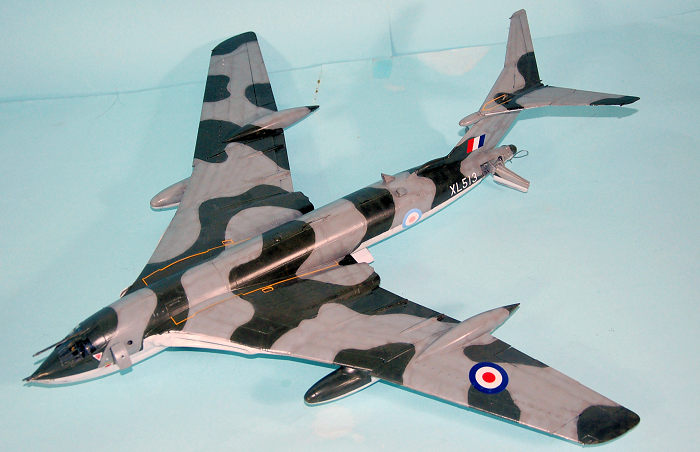 panded
by an insert in the wing and a larger wingtip, changed tailcone, all-new
electrical system and many other modifications, the first B.2 flew in February
1959.
panded
by an insert in the wing and a larger wingtip, changed tailcone, all-new
electrical system and many other modifications, the first B.2 flew in February
1959.
The B-2 entered service just in time to stand alert during the Cuban Missile Crisis in 1962. The final B.2 off the production line was delivered to the RAF in May 1963. The role soon changed to low-level bombing in 1964, and with appropriate green and grey camouflage replacing the earlier anti-flash white, XL513 being the first changed, with a one-off scheme different from what would become standard, and the B.2 force was also equipped with the Blue Steel nuclear missile.
1963 saw the first hint of action for the Victor when several were deployed to Singapore in December as a show of force during the confrontation with Indonesia over Malaysia. Indonesia backed down when further Victors were deployed in 1964.
In 1966, XL513, which had deployed to Australia, suffered a bomb-bay fire on the return flight and was forced to land at Gan in the Maldives south of India. A team from Handley Page went out and re-wired the bomb-bay. 139 Squadron technician Tom Muir recalled, “We went out to service and check out all the aircraft systems. After a fire, re-wire, five weeks on the ground in tropical salt-laden air, there were many crossed fingers when she gingerly took to the air again. We must have done a reasonable job as she flew safely home none the worse for her ordeal.”
| THE KIT |
Revell released a 1/72 Victor K-2 in the early 1980s (this being the Matchbox tooling. Ed), which was the only plastic kit of this aircraft until Airfix released this B.2 in 2016. They have now released the kit as a Victor K.2 tanker. This kit is the only one to depict the bomber. There was a very old Lindberg release in 1/96 scale of the prototype HP.80 back in the last 1950s.
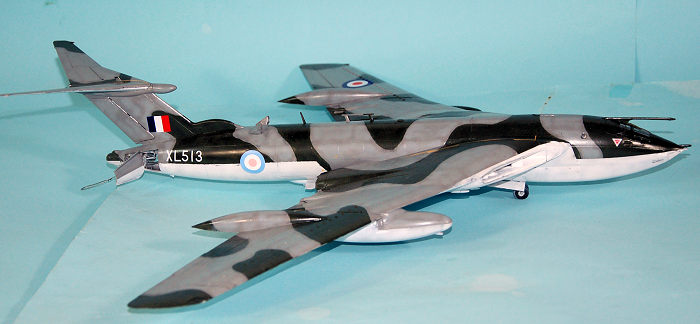 The
kit is thoroughly “new Airfix,” with quality moldings and good kit design. The
now-standard excellent Airfix instruction booklet clearly shows what new parts
are the subject of each logical step of construction; this is very helpful with
a kit that is as complex (but not complicated!) as this is.
The
kit is thoroughly “new Airfix,” with quality moldings and good kit design. The
now-standard excellent Airfix instruction booklet clearly shows what new parts
are the subject of each logical step of construction; this is very helpful with
a kit that is as complex (but not complicated!) as this is.
A detailed cockpit is barely visible if one opens the side hatch to allow light inside. Two different aircraft - one in the overall white anti-flash scheme, and one in the later camouflage scheme, are supplied in the decal sheet along with cious in-scale stenciling.
Xtradecals released sheet 72265 with several Victor bombers, including XL513 with its unique markings and scheme.
| CONSTRUCTION |
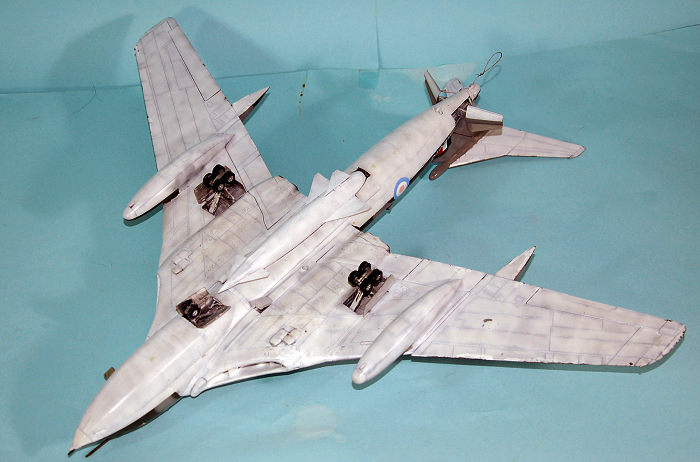 This
is a big model, even in 1/72, and swinging it around as one progresses through
the build will break off small details. I highly recommend that the wing pitot
tubes and all antennas be left until the final step in your assembly. That way,
you won’t have to make new pitots from Evergreen rod, as I did.
This
is a big model, even in 1/72, and swinging it around as one progresses through
the build will break off small details. I highly recommend that the wing pitot
tubes and all antennas be left until the final step in your assembly. That way,
you won’t have to make new pitots from Evergreen rod, as I did.
That said, if you take the radical step of following the instructions, you will have a trouble-free build. Everything fits, and the ultimate result looks good.
I painted the cockpit interior without going into great detail, since one can really only see the pilot’s seats once everything is installed and assembled. I also painted the interior of the air intakes white before further assembly. Finally, I attached the landing gear as early on as possible, so the model could sit. It requires plenty of weight in the nose, and the fish weights completely filled the area below the cockpit floor.
| COLORS & MARKINGS |
I followed the paint scheme for XL513 in the Xtradecals instructions,
using Tamiya gloss white, and Tamiya Sea Grey Medium and RAF Dark Green. Looking
at a photo of XL513, it is clear it was not done with the “hard edge” camo
scheme, so I was able to freehand the scheme. I gave it some weathering so it
would 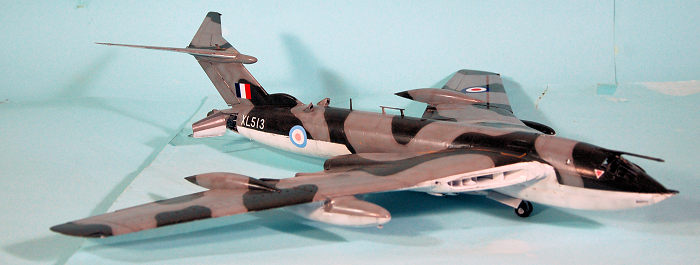 look
like the original had looked after its five weeks in the tropical Maldives.
look
like the original had looked after its five weeks in the tropical Maldives.
The kit decals were used for the national markings and the stenciling. Fortunately four “light” roundels were included on the sheet, so I could apply a double thickness for the fuselage markings; the decals were not opaque enough to deal with the various camouflage colors they were applied over. Fortunately, the upper wing insignia was sufficiently opaque. I finally gave up on all the stenciling halfway through, given their small size; you can barely see them once applied.
I painted the landing gear and wheel bays with Tamiya Flat aluminum, and applied a coat of Micro-Scale Satin overall, to give the model the “gloss” finish of the time, but in scale.
| CONCLUSIONS |
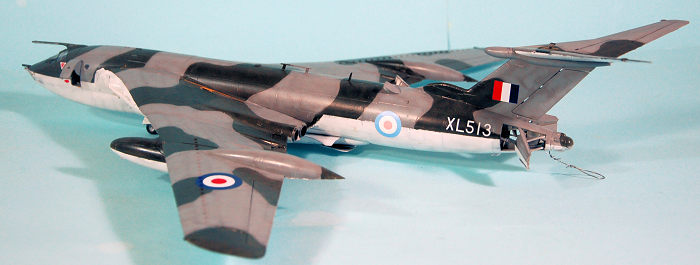 I
have always thought the Victor was the most interesting of the three V-bombers
in terms of its aerodynamic shape - it even gives the Vulcan a run for its money
in terms of aerial aesthetics. This kit by Airfix is not difficult, though I
would recommend it only to intermediate modelers and above, due to its
complexity. My suspicion is the K.2 release will prove more popular. Highly
recommended.
I
have always thought the Victor was the most interesting of the three V-bombers
in terms of its aerodynamic shape - it even gives the Vulcan a run for its money
in terms of aerial aesthetics. This kit by Airfix is not difficult, though I
would recommend it only to intermediate modelers and above, due to its
complexity. My suspicion is the K.2 release will prove more popular. Highly
recommended.
8 November 2018
Copyright ModelingMadness.com
Review kit courtesy of Hornby America. Decals courtesy of the late and deeply-missed David Hannant.
If you would like your product reviewed fairly and fairly quickly, please contact the editor or see other details in the Note to Contributors.
Back to the Main Page Back to the Review Index Page Back to the Previews Index Page